On Dec. 13, 2018, Gene "Randy" Backe, of Cloquet, was diagnosed with malignant mesothelioma likely resulting from asbestos exposure, according to a doctor’s report. He died as a result of the cancer on Sept. 28, 2020, at age 76.
In 2019, Backe and his wife, Carol, filed a liability claim against the Conwed Corp., seeking punitive damages as a result of the secondhand asbestos exposure Backe claims he suffered at the hand of the factory.
Since closing its Cloquet headquarters in 1985, the Conwed Corp. has faced hundreds of claims from former employees and their families alleging they developed health issues as a result of their time spent in the factory.
From roughly 1958 until 1974, Conwed, formerly known as the Wood Conversion Co., used asbestos in the production of its Lo-Tone mineral board and ceiling tile products, potentially exposing about 6,000 workers to the hazardous ingredient.
Asbestos is a fire-resistant material that was largely used in production factories throughout the 1900s. It is now known as the leading cause of multiple health defects, such as lung diseases like asbestosis and mesothelioma — a cancer that can take up to 20 years to present itself and has a life expectancy of five years or less.
ADVERTISEMENT
According to a study published by the Minnesota Department of Health in 1993, approximately 30% of former Conwed workers screened by the state suffered from lung abnormalities that may have been caused by asbestos exposure.
Since then, many former Conwed employees and their families have come forward with claims against the company.
However, most of those affected are limited in their ability to hold Conwed accountable due to state laws that prevent Minnesota employees from suing their employer.
The legal details
Workers' compensation is an exclusive remedy under Minnesota law, meaning that an employee is unable to sue their employer for civil damages outside of the workers' compensation system.
This means it is rare for an injured Conwed employee to take their case further than a simple claim and quiet settlement.
However, there are some exceptions, such as the Backe case, which may be one of the few to see a court trial.
The case, filed in July 2019, claims Conwed provided no warnings to its employees about the dangers of asbestos and did not take adequate safety precautions, leading Backe’s father — a long-time Conwed employee — to unknowingly expose his household to asbestos, which in turn led to Backe’s development of mesothelioma.
ADVERTISEMENT
Backe himself was also a Conwed employee on and off for about two years.
According to Conwed’s corporate counsel, Robert Brownson, Conwed has adequately compensated the Backe family for their asbestos injuries under the workers' compensation laws, in addition to paying all medical and funeral expenses.
“In essence what they’re trying to do is get paid twice for the same injury,” Brownson said. “We have limited assets, and we shouldn’t be paying people twice.”
Because of this, Conwed contends the plaintiffs have no basis for further payment. The corporation also argues that “mere negligence” does not constitute a claim of punitive damages.
“Mr. Backe was actually a Conwed employee, during which he would have had the bulk of his alleged Conwed asbestos exposure,” Conwed said in a 2019 court opposition. “The ‘additional’ exposure upon which his indivisible injury of mesothelioma is based was only slight and incidental at best.”
In light of Backe’s death, Carol Backe has opted to change the case from a product liability suit to a wrongful death suit. Brownson said she has also filed a dependency claim, for which Conwed will pay her.
The Backe trial date was originally set for Feb. 22, 2021, but was deemed “non-essential” in the COVID-19 pandemic after Backe’s death and has been pushed to May 17.
ADVERTISEMENT
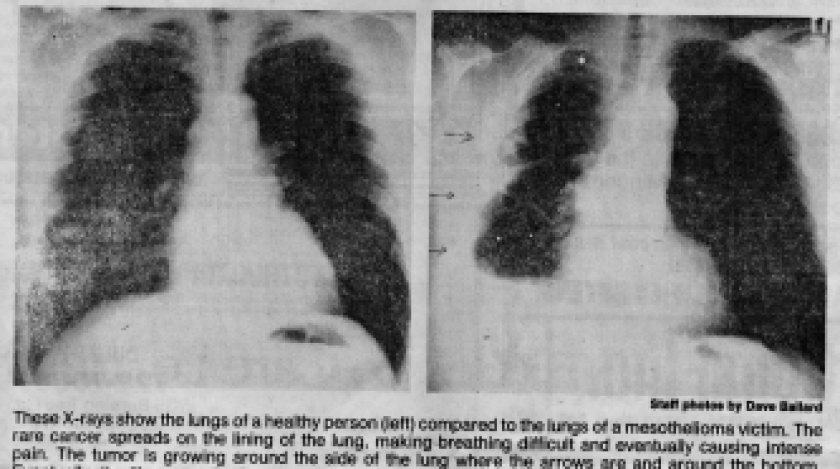
“Mrs. Backe and the residents of Cloquet and the surrounding areas continue to suffer the consequences of Conwed’s indifference,” Chad Alexander, of the Sieben Polk law firm, said in a statement to the Pine Journal.
Carol Backe declined to provide a comment for this article due to pending litigation.
Behind the case
Backe spent most of his life as a Cloquet resident. From the time he was born in November 1943 until he married in 1966, Backe lived with his parents, Gene and Esther, in their Cloquet home located just about a mile from Conwed.
He remembered visiting his father at the Conwed factory when he was in high school. In court testimonies, he recalled walking through the area where his father worked and seeing bags of what he later learned was asbestos being dumped into large machines.
According to court records, Backe’s father worked as a millwright in the factory from approximately 1935 until 1975. He was mainly responsible for fixing plant machinery located in the factory's Mill C and Lo-Tone areas, which were later found to be heavily contaminated with asbestos.
Gene and Carol Backe began dating in 1962, and she was often in the family’s home during that time. She remembered seeing Backe’s father come into the house after work with clothes covered in dust.
ADVERTISEMENT
“I couldn't believe how white it was … you wouldn't know what the color was unless you saw the other suit or if he had just put on a fresh one,” she said in a 2019 court deposition.
The plaintiffs testified that the dirty work clothes were often hung on hooks alongside the family’s jackets, and Backe often assisted his mother with the laundry, shaking off his father’s work overalls in a room near the kitchen.
He would also regularly drive his father’s car, which he said was always filled with the same white dust.
Backe eventually followed in his father’s footsteps and began working at the Conwed factory on and off while he was in college, starting in 1963 and lasting until 1965.
He even worked in the same areas as his father: Mill C and Lo-Tone. During a deposition, he described the Lo-Tone area as very fast-paced and dusty.
“(I)t kind of looked like a snowstorm,” he said. “It was always dusty without fail.”
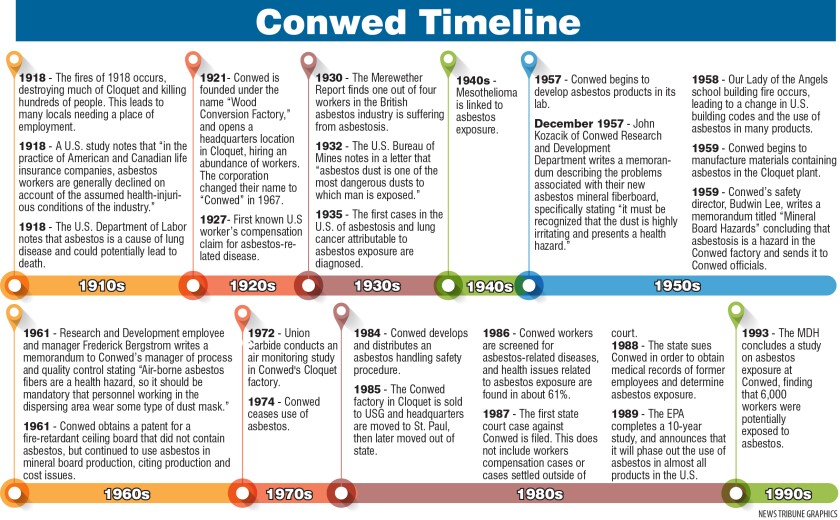
ADVERTISEMENT
When Carol and Gene Backe married in 1966, he moved out of his parents’ home, but the two spent most of their life together in Cloquet, and would visit his mother and father weekly.
Backe graduated from college in 1968, and the pair moved to the Twin Cities area for about a year, after which they returned home to Cloquet, where they remained for the rest of their lives.
Backe previously smoked and occasionally used alcohol, but had quit smoking about 30 years prior to his mesothelioma diagnosis, according to a doctor's report.
Most of Backe’s career was spent teaching elementary school in Carlton, and in his later years, he worked as a substitute teacher. He and Carol had two children and three grandchildren.
Backe also had siblings, one of whom died of a "breathing disease" sometime around 2017, Backe said in a deposition. Family history given in a doctor's report indicated his father suffered from heart disease and his mother had a history of melanoma.
Shortly after his diagnosis, Backe lost the ability to do many everyday tasks, and had to stop teaching.
“I can't do much,” he said in a court deposition. “I used to mow my lawn and I'd get done within two tank-fulls easily. Now, I can't get done in three well; I don't even try anymore. My grandson cuts the grass. … The only thing I still do is … every day I water my dad and mother's gravesite and Carol's mom and dad('s gravesites). That's it.”
According to Carol’s 2019 deposition, Backe became weak and started to suffer from falls.
ADVERTISEMENT
“His health is deteriorating daily,” she said. “He is not able to walk far. He has to spend a lot of time in bed. His condition is bad.”
Carol once shared that he had fallen badly three times in one week.
“(H)e tripped on the sidewalk … he has a lot of scrapes and a black eye,” she said. “He broke his glasses.”
Carol’s father, Clifford Sather, also worked at Conwed and she said she would not have been surprised if he had suffered from health issues as many other workers have.
The aftermath
Backe is not the first Conwed employee to develop mesothelioma. According to court records, there have been 39 cases that reportedly came out of the plant since the 1980s.
Before Backe’s case, the most recent mesothelioma case brought against Conwed was by former employee Darrel Drewlow and his wife, Beverlee, after Darrel was diagnosed with mesothelioma. He died in 2018, and the results of the case are considered confidential.
It is not uncommon for mesothelioma legal cases to progress quickly due to plaintiffs’ shortened life expectancies.
The majority of concern for Conwed workers started in June 1986 when approximately 270 Conwed workers were screened for asbestos in their lungs.
By August 1986, the Duluth News Tribune reported that 61% of those screened had been diagnosed with health issues related to asbestos exposure, and more screenings followed.
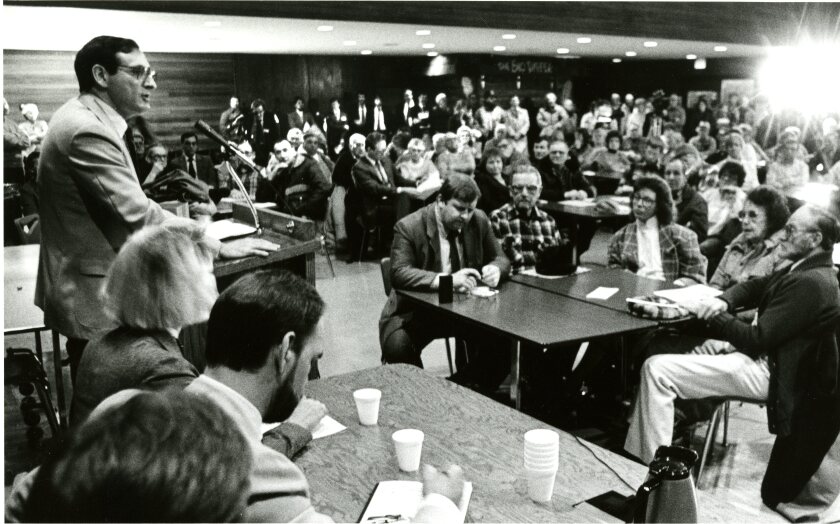
“It scares me,” former Conwed employee Raymond Jaski told the Duluth News Tribune in 1989. “I will have physicals every six months for the rest of my life.”
Not all Conwed employees voiced negative feelings, even when asbestos was found in some of their lungs.
"There's no point in getting angry," former worker Glen Richards told the Tribune in 1989. "You're only going to live 'til you die anyway."
That year, the News Tribune reported that health officials found the rate of lung cancer death among Cloquet men to be 36% higher than elsewhere in the state and the rate of mesothelioma was 70 times the normal rate.
“Conwed is a killer,” an attorney representing the Backe family said in a court transcript.
A murky history
Conwed was founded in 1921, shortly after the fires of 1918 left many Cloquet area residents without work. It employed hundreds of workers at a time, and began using asbestos in production in 1958, although lab development for asbestos products began around 1957.
Court documents show a 1957 memorandum written by J.J. (John) Kozacik of Conwed Research and Development Department to H.E. Walter, director of manufacturing, among others, describing the problems associated with the new asbestos mineral fiberboard.
"(I)t must be recognized that the dust is highly irritating and presents a health hazard," the memo read.
In 1959, Conwed safety director Budwin Lee also wrote a memorandum titled “Mineral Board Hazards” to five Conwed officials: H.E. Walter, B.J. Lee, A.L. Spafford, G.E. Allen and H.E. Patterson.
It warned of the health issues surrounding asbestos, including skin irritations and lung diseases, and addressed ways in which the company could keep its employees safe, such as protective gear and X-rays.
As of date, there is no documentation showing that Conwed issued any official warnings or safety messages to its employees following the 1959 memo.
“It certainly wasn’t something that was hidden from people,” Brownson said. “We performed due diligence and review of this new material as responsible people would.”
He acknowledged that there is no definitive evidence on whether Conwed told its employees of the risks surrounding asbestos.
According to Brownson, the owners of Conwed lived and worked in the factory and would not have jeopardized the safety of themselves or their employees, many of which they considered friends.
He said Conwed “always” had masks available, but that many employees chose not to wear them, and that the International Paper Workers union required them to be worn on a voluntary basis.
Former Conwed employee Bernie Karulak said he was never warned of the risks of asbestos.
“They never had masks or anything,” he said.
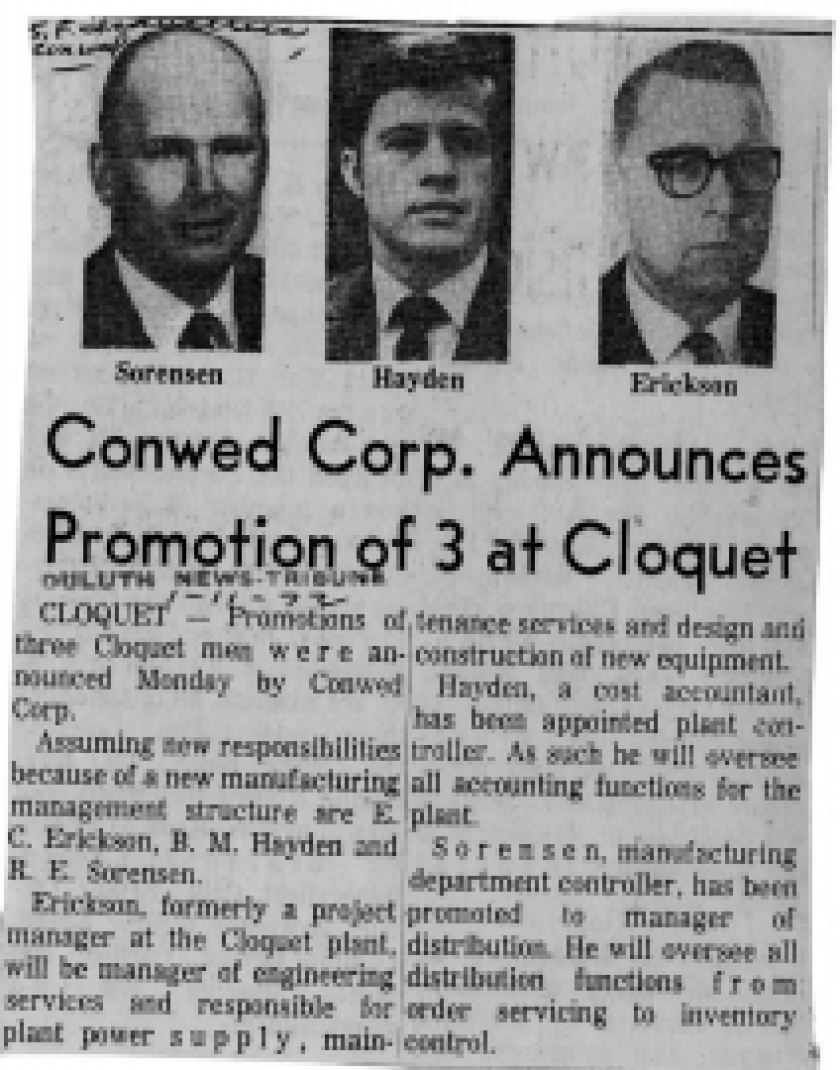
Karulak lives in the Cloquet area and worked at Conwed for about 29 years. He’s 82 years old now and has asbestos in his lungs. He said he doesn’t believe he has much time left.
“I feel kind of peeved about it,” he said. “They’re the ones that really took everything out of us.”
Karulak received a small settlement from Conwed — enough to pave his driveway. He said the work at Conwed was always fast-paced and dusty.
“I don’t actually believe anybody could have worked in worse conditions,” former Conwed employee George Garrett told the Duluth News Tribune in 1986. “You coughed and sneezed an awful lot.”
Garrett worked at Conwed for 22 years and said asbestos exposure at the factory was extensive.
“We was wading shoe-deep in the dog-gone stuff,” he said.
Conwed claims there was a continuous effort to reduce dust within the mill by improved ventilation and dust control equipment and processes.
Court documents and testimonies state that dust masks, and possibly other respirators, were made available to employees, as well as lockers and showers. It is also said in documents that these efforts were taken as a result of dust generally in the manufacturing process, and not specifically asbestos.
Brownson said quantities of asbestos in the plant were limited to a maximum of 5 mppcf (million particles per cubic foot of air) per state regulations.
Asbestos attorneys argue Conwed did not begin testing air quality in the plant until after regulations implemented by the Occupational Safety and Health Administration in 1972.
“Evidence shows Conwed knew asbestos was hazardous no later than 1958, and there is no evidence that Conwed tested the asbestos air concentration in its plant before 1971, despite Minnesota regulations requiring them to do so going back into the 1950s,” Alexander said.
In 1961, Research and Development employee and manager Frederick Bergstrom wrote a memorandum to Conwed’s manager of process and quality control, Allen Crewson, which he later noted as stating: "Air-borne asbestos fibers are a health hazard, so it should be mandatory that personnel working in the dispersing area wear some type of dust mask."
Bergstrom told the court in a 1991 deposition that his recommendation was never used in the corporation.
Clarence Maki worked at the Conwed factory for roughly 30 years and developed mesothelioma. He said he didn't see a mask in the plant until around 1976.
“I felt bitter, I really did, because I was one of the guys who wasn’t informed, if anybody was even,” he told the Duluth News Tribune shortly before his death in 1989. "I don’t really know. Somebody should have known what was going on.”

Conwed Safety Director Ben Anderson testified in 2017 that Conwed followed safety regulations and never intended to risk the safety of employees.
Conwed's history with asbestos
Brownson said Conwed largely used asbestos due to its fire-resistant qualities in efforts to prevent fires such as the 1958 Chicago school fire that killed 92 children and three nuns.
Around the time of the fire, building codes and regulations in the U.S. largely changed, eliminating the use of wooden ceiling tiles.
“If you think about it, it probably did save a lot of schoolchildren,” Brownson said. “We responsibly analyzed these new products. … We thought it was all safe.”
Court documents show a patent obtained by Conwed in 1961 for a non-asbestos, fire-retardant mineral board.
“Conwed has never produced a single document suggesting (safety) was their motivation, or that the inclusion of a known hazardous material produced a safer product than the asbestos-free Lo-Tone ceiling tile they admit they always had the ability to manufacture,” Alexander said. “Instead, Conwed chose to use asbestos despite knowing that it was hazardous and that both its own employees and others exposed were being put at risk of contracting fatal diseases.”
Bergstrom said in a court testimony that they ceased using asbestos from 1961 until 1964, but then resumed manufacturing both asbestos and non-asbestos materials, citing production issues and the cost of obtaining a UL fire rating for the new product.
On May 23, 1966, an article in the St. Paul Dispatch warned of ties between asbestos and lung cancer. Bergstrom said this made the connection between asbestos and lung cancer more concrete for Conwed.
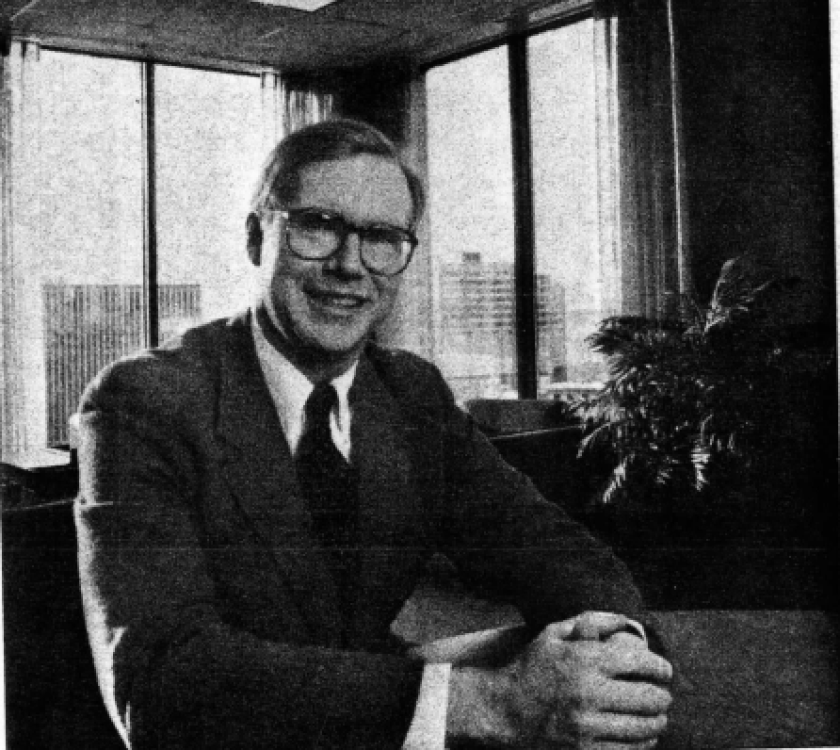
Frederick “Ted” Weyerhaeuser became Conwed president in 1972. He said in a 2003 testimony that it was difficult to put a date on when Conwed became aware of the hazards of asbestos, stating “the first concern was ’71 or ’72, when there was a lot of local publicity, like, the Duluth papers, about taconite tailings from Reserve Mining being discharged into Lake Superior at Two Harbors.”
In 1972, Conwed’s asbestos supplier at the time, Union Carbide, was contacted and asked to take dust tests in the Cloquet plant in areas where asbestos was used.
In 1974, Conwed ceased asbestos use entirely and a purchasing agent named Lorin Palmer arranged a sale of the remaining asbestos to Boise Cascade in International Falls.
Conwed’s former director of operations, Joseph King, said in a 1993 deposition that the company gave no warnings to Boise Cascade when completing the asbestos sale.
There are currently claims stemming from the Boise Cascade factory that list Conwed as a defendant.
In 1984, Conwed developed asbestos handling procedures and guidelines to comply with OSHA standards and instructed Bergstrom to compile a report of their history with asbestos.
Where is Conwed now?
In 1985, Conwed sold its factory to the U.S. Gypsum Corp. and moved operations out of Cloquet to St. Paul, laying off about 700 workers.
Brownson said the move was unrelated to any litigations.
Conwed eventually moved out of state and has since ceased all production. According to Brownson, it has spent most of its remaining funds paying off claims.
“Conwed … doesn’t have a lot of money left,” he said.
In instances such as the Backe case, Conwed has often tried to argue jurisdiction issues because it no longer operates in Minnesota. Most of these motions have been denied, with the argument that “you can change where you are, but you can’t change what you’ve done.”
Conwed has also filed liability claims against one of its former asbestos providers, Union Carbide, alleging that they did not adequately warn Conwed of the dangers of asbestos, and should therefore be held accountable to help pay for claims filed by former Conwed employees.
Typically, Conwed is listed as one of many defendants in court filings, tried alongside others such as Union Carbide.
The Conwed factory events have been cited in multiple asbestos studies, with the most recent one completed by the University of Minnesota in 2014.
According to coverage in the Duluth News Tribune, during the initial Minnesota Department of Health investigations into Conwed, the state was forced to sue the corporation upon its delay in releasing records of employees who may have been exposed to asbestos.
The battle ended several months after the initial state requests when Conwed released the records to the state, but the final study published by the health department in 1993 states: “Conwed has not provided the State with information about the types and amounts of asbestos used during different years.”
Brownson said Conwed has since released this information, and it would be strange for the health department to not have it.
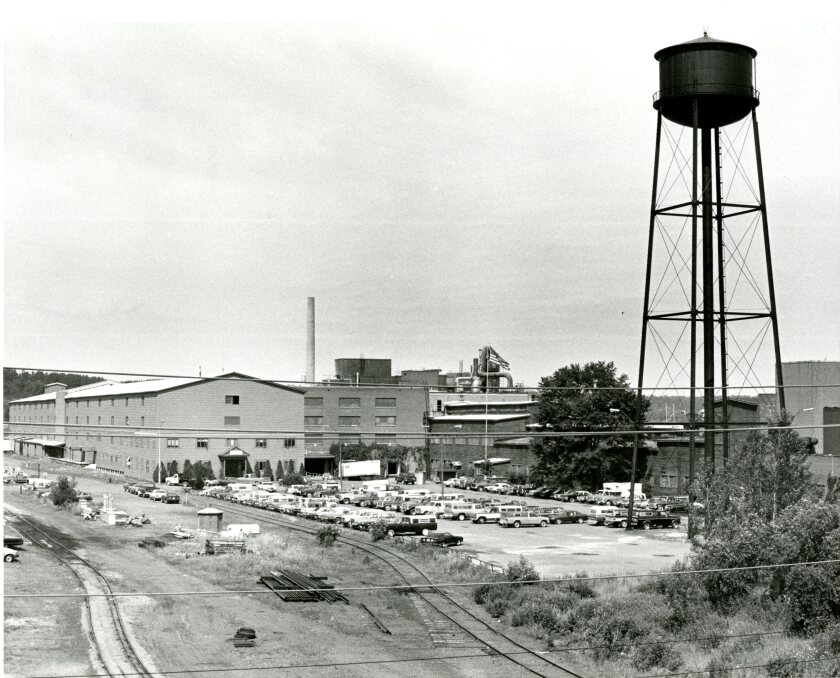
Most Conwed officials involved in decisions at the Cloquet location have died since the asbestos claims began.
King died in 2007 at age 82 from mesothelioma, and Weyerhaeuser died in 2020 after falling on ice outside his home.
Those that have died and those who remain continue to have their testimonies presented in court.
There are multiple attorneys involved in the various litigations. All filed cases occur in the designated Minnesota asbestos court in Ramsey County.
Brownson has worked for Conwed since roughly 1986 and continues to act as corporate counsel for the company. He said Conwed has been unable to issue a public statement due to active litigations, but that they hope the cases end soon.
“It’s a tragic historical story,” he said. “We just have to deal with it.”







